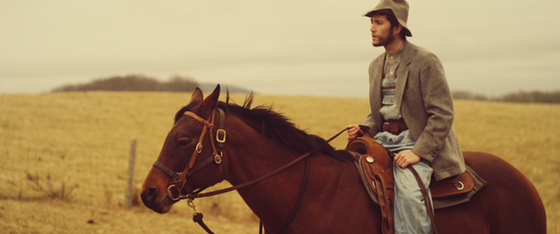|
Since I have never Kickstarted anything before, I interviewed 4 friends who created and funded 3 different projects on Kickstarter.
1.) What was your Kickstarter?Andrew and Rachael: We ran a Kickstarter to fund the remaining five issues for a six issue comic mini-series called Schismatic. We raised 108% of our goal. We asked for $12,000. All of that money went toward page rates. Evan: Three years ago I was part of the "Six Seasons and a Movie" Community Art Show Kickstarter, curated by PixelDrip Gallery. When the NBC cult sitcom Community ended its third season and it looked like it was fated to never return, we at PixelDrip felt obliged to hold a fan-art show as a tribute. Fans of the show must have felt the same way, because we got funded nearly 200% from our initial goal of $3500! Matthew: My Kickstarter was for a "western" short film called Restitution. It involved a lot of moving parts such as stunts, horses and animal handlers, difficult locations for equipment trucks to navigate, and a variety of other variables. I wanted to be sure that I had enough capital to ensure success for such an ambitious project for a 21 year old. 2.) What are your tips and tricks for getting funded? Andrew and Rachael: (Andrew) Ask people for money directly, and personally. I was stunned to see who came out in support -- like old high school contacts who I was friendly with but not close to -- and they only did it after I sent a personal e-mail. Blanketing my social media feeds with requests wasn't enough, because it's impersonal. So ask directly. A site like www.greeninbox.com can send out mass e-mails, and make the "direct/personal ask" very fast (if you can make it seem like it's not a form letter). Also: Ask Bleeding Cool to let you write an article for them, and they'll feature you to a big community. Make a good video, and show your art. Add 'Kickstarter Exclusive' rewards -- they're attractive. $25 is a very common pledge -- put your key reward at $25. We made our exclusive reward at $50, and that also worked. Make sure that you have some high (but reasonable) rewards, in case anyone's feeling friendly. Build buzz in advance by letting everybody know that you're working on a project, and sharing updates. We also gave out our first issue before the campaign closed, and we had a lot of people increase their pledge to read the rest. Not a ton, but enough. And only one person took the first issue and cancelled their $5 pledge, so ultimately it earned us far more money than it lost. (Rachael) First, do a lot of research. Find out how much money past successful Kickstarters in your category typically raise, and find places and higher up people to send your Kickstarter to once it launches in order to gain exposure; or do what I did and find someone to partner with who knows about networking and marketing (yo yo Andrew Adams). The first week or two will mostly be just from friends and family. And while there is usually a big push at the last week, being able to get your work seen by strangers is what will help you reach your goal Another important factor is to offer your donors something they won’t be able to get after the Kickstarter. Our rewards that really got a lot of attention were the tiers where you could be drawn into the comic. These sold out very quickly and, I feel, really made the donors feel like they were getting their money’s worth and were also getting a special experience that will never be available again in this story. Evan: While every Kickstarter campaign is going to be different, there are a few tips and tricks I've noticed that can help one get funded. First, update your Kickstarter frequently; daily, if not twice daily. People who are giving you money want to feel like you are taking your project seriously. It is also helpful to have gifts that someone would want, but also gifts that are realistic for you to produce. Don't offer a hand-made doll to your $5 funders... Save the really sweet perks for the people that give you triple digits. It is also extremely helpful to be making a project with some built-in fan recognition, or to already have built a strong reputation for your own work if you are trying to fund a personal project. When we started out Kickstarter, PixelDrip was relatively unknown, but the show Community had a huge underground fan base. They saw something they wanted that we were providing, and they jumped on the opportunity to make the fan-art show a reality. Funding personal projects is always harder, but if you spend the time to make good artwork and spread it across social media, it will go a long way towards building your fan base and your reputation for when you are ready to make that film or comic book or solar-generated Rumba. Matthew: Most of my donations came from people I knew, or people that who were friends of people that I know. I would usually have to call people up as some donors just don't do anything unless they are poked... Donating $25 to someone isn't really on a lot of peoples' high priority list due to day-to-day events that push it to the back burner. I used social media, but really I needed a larger following to begin with before I could rely on that. Expecting donations because your project is "cool" or "unique" doesn't really make sense. There are plenty of great projects around, so unless yours is the 1 in a million, you need to treat it as a part time job. 3.) What was the hardest part? Andrew and Rachael: (Andrew) Asking people for money. It sucks on your end, but ultimately you're talking to somebody who loves you and wants to support you and doesn't mind you asking at all, so just do it. Or: they won't donate, but whatever, they don't care that you asked. So just do it. (Rachael) Managing e-mails and contacts. I was overwhelmed by the amount of people I had to reach out and respond to, and I barely got any compared to my poor partner! Having a Kickstarter is essentially another full time job; I don’t recommend doing it alone. And the awful two week lull that happens in the middle of the funding. Suddenly you go from getting $1000 a day to $50, if that. Evan: The hardest part was staying on budget and fulfilling the donation gifts. What you are very concerned about when you start a Kickstarter is how much money you will need to pull off your project. What you forget about is the hidden cost of producing and mailing all of your promised gifts to your funders. We spent almost 3 months after the show was over getting the gifts together and shipping them out. It was a good thing we made twice our goal, because we used it all to produce and mail our gifts. Whatever you think your project will cost, double it. In fact, triple it. You may be weary about asking for that much money from people, but it is far better to have a reasonable budget that fails than to be funded and not end up having enough money to complete your work. Matthew: The hardest part for me was the back-end shipping. Out of necessity I had to move on to other work as I freelance full time, and not planning a transition period between my project and work was horrible. Many long nights trying to get everything ready and many early mornings not feeling rested because making prizes (depending on what they are) simply takes time. It needs to be accounted for. 4.) What would you do differently next time? Andrew and Rachael: : I think our campaign would have been more successful if we'd found a way to add print rewards. I don't know how that's possible, given what we requested, but I think it would have netted more backers. And I'd be curious to try a shorter campaign. The middle weeks were a slog -- you'd go up 1% or 2% a day -- and it seemed like only the first 3-4 and last 3-4 days really made an impact. I'm curious if a shorter campaign would encourage energy/momentum or not. Who knows!
Evan: The next time I do a Kickstarter I want to try doing a personal project. It is far more difficult than doing a project with a built-in fan-base but with a little can-do attitude doesn't seem impossible. I would absolutely not be afraid to start a video blog and update every day. I would also urge everyone doing a Kickstarter to be open and transparent about what the money is going towards, even if it’s late-night meals to help you stay alive while you print postage stamps for your three-hundredth funder gift. More often than not, you'll be pleasantly surprised at how generous people will be if you are straight-forward and honest with them. Matthew: I think that the most important thing that I learned (and subsequently would do differently) is how to value what I was creating and what my time was worth. I found very quickly that the money that I did get was after a lot of work (felt like a part time job) and then I had to create/ship prizes to my backers after completion, which was extremely difficult as I needed to switch gears into freelancing just to survive. Understanding a better number of how much capital to ask for, and also planning a lot more in depth as to when and how I would set aside time for the back-end of the process is absolutely crucial. Making time to plan the kickstarter is Key, and that is not necessarily easy to do when regular life gets in the way.
2 Comments
|
Meghan Boehman Art
Art tips I learn and helpful resources that I find. Archives
April 2016
|










 RSS Feed
RSS Feed
